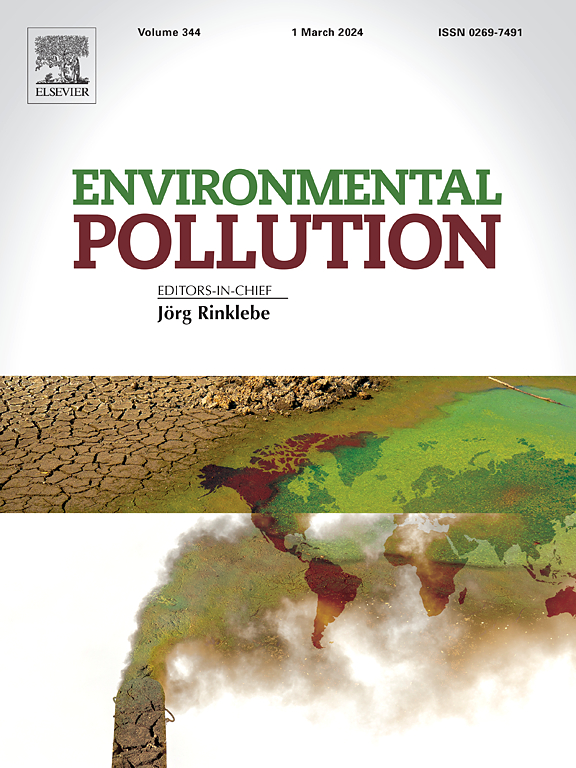尿素修饰污水污泥生物炭的合成及其电子转移途径对磺胺甲恶唑的高效降解
IF 7.6
2区 环境科学与生态学
Q1 ENVIRONMENTAL SCIENCES
引用次数: 0
摘要
抗生素残留在环境基质中的广泛存在构成了重大的生态风险。本研究以废活性污泥和尿素为原料,采用简单实用的方法合成了n掺杂污泥生物炭(NSBC)。合成的NSBC用于激活高碘酸盐(PI),以有效去除水溶液中的磺胺甲恶唑(SMX)。尿素的掺入显著提高了生物炭的吸附能力和催化氧化性能,在60分钟内完全去除SMX,同时在较宽的pH条件下保持较高的去除效率(3-9)。干扰实验表明,常见阴离子(Cl-、SO42-和NO3-)对SMX的去除有较小的抑制作用,而腐殖酸和3种天然水系的复合基质的存在使SMX的去除效率保持在70%以上。淬火实验、电子顺磁共振和电化学分析证实SMX的降解主要是通过电子转移机制促进的非自由基途径进行的。对降解产物的分析和ECOSAR模型的预测表明,SMX转化为一系列更小、低毒性的中间产物,显著降低了其对种子萌发的抑制作用。本研究提供了一个可持续的策略,为废物污泥的价值和生态友好的解决方案,以减轻抗生素污染。本文章由计算机程序翻译,如有差异,请以英文原文为准。


Facile synthesis of urea-modified sewage sludge biochar for efficient sulfamethoxazole degradation via an electron transfer pathway
The widespread presence of antibiotic residues in environmental matrices poses significant ecological risks. In this study, N-doped sludge biochar (NSBC) was synthesized through a straightforward and practical method using waste activated sludge and urea. The synthesized NSBC was employed to activate periodate (PI) for the efficient removal of sulfamethoxazole (SMX) from aqueous solutions. The incorporation of urea markedly enhanced the biochar's adsorption capacity and catalytic oxidation performance, achieving complete SMX removal within 60 min, while maintaining high removal efficiency across wide pH conditions (3–9). Interference experiments revealed that common anions (Cl−, SO42−, and NO3−) exerted minor inhibitory effects on SMX removal, while the presence of humic acid and the complex matrices of three natural water systems maintained SMX removal efficiencies above 70 %. Quenching experiments, electron paramagnetic resonance, and electrochemical analyses confirmed that the degradation of SMX primarily occurs via a non-radical pathway facilitated by an electron transfer mechanism. Analysis of degradation products and predictions from the ECOSAR model suggested that SMX was transformed into a series of smaller, low-toxicity intermediate products, significantly diminishing its inhibitory effect on seed germination. This study offers a sustainable strategy for waste sludge valorization and an eco-friendly solution for antibiotic pollution mitigation.
求助全文
通过发布文献求助,成功后即可免费获取论文全文。
去求助
来源期刊

Environmental Pollution
环境科学-环境科学
CiteScore
16.00
自引率
6.70%
发文量
2082
审稿时长
2.9 months
期刊介绍:
Environmental Pollution is an international peer-reviewed journal that publishes high-quality research papers and review articles covering all aspects of environmental pollution and its impacts on ecosystems and human health.
Subject areas include, but are not limited to:
• Sources and occurrences of pollutants that are clearly defined and measured in environmental compartments, food and food-related items, and human bodies;
• Interlinks between contaminant exposure and biological, ecological, and human health effects, including those of climate change;
• Contaminants of emerging concerns (including but not limited to antibiotic resistant microorganisms or genes, microplastics/nanoplastics, electronic wastes, light, and noise) and/or their biological, ecological, or human health effects;
• Laboratory and field studies on the remediation/mitigation of environmental pollution via new techniques and with clear links to biological, ecological, or human health effects;
• Modeling of pollution processes, patterns, or trends that is of clear environmental and/or human health interest;
• New techniques that measure and examine environmental occurrences, transport, behavior, and effects of pollutants within the environment or the laboratory, provided that they can be clearly used to address problems within regional or global environmental compartments.
 求助内容:
求助内容: 应助结果提醒方式:
应助结果提醒方式:


